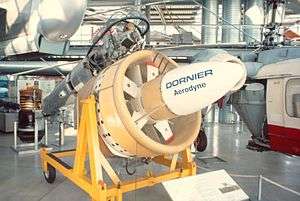Dornier Aerodyne
The Dornier Aerodyne was the designation of a "wingless" VTOL unmanned aircraft. Conceived by Alexander Lippisch, it was developed and built by Dornier on behalf of the Federal German Ministry of Defense. Lippisch was part of the team. The first flight took place on 18 September 1972. The development ended on 30 November 1972 after successful hovering-flight testing with the aircraft. Experimentation did not continue due to lack of interest in the Bundeswehr (German Armed Forces), and/or the desire to undertake plans for manned helicopters.
| Aerodyne | |
|---|---|
 | |
| The Aerodyne on display at the Deutsches Museum Flugwerft Schleissheim | |
| Role | VTOL Experimental aircraft |
| National origin | West Germany |
| Manufacturer | Dornier Flugzeugwerke |
| Designer | Alexander Lippisch |
| First flight | 18 September 1972 |
| Retired | 30 November 1972 |
| Primary user | BMVg |
| Number built | 1 |
Description
The principle behind the Aerodyne is the combination of lift and thrust production in a single construction unit and flow channel, i.e. a ducted fan. Flaps at the end of the fan divert the outflowing air to produce lift, thrust, or a combination of both. As a result, the Aerodyne could be steered and flown in the entire range between hovering and full-forward flight.
For forward flight, the Aerodyne had a conventional tail unit at the rear, which allowed for pitch and yaw control. The equipment was unmanned and operated by remote control.
It was intended to be a land- or ship-supported drone (UAV) for aerial reconnaissance.
Specifications
- Length: 5.5 metres (18 ft)
- Width: 1.9 metres (6 ft 3 in)
- Fan Diameter: 1.1 metres (3 ft 7 in)
- Engine: 1 MTU 6022 A-3, 370 shaft horsepower (280 kW)
- Total Weight: 435 kilograms (959 lb)
References
"Eine Dokumentation zur Geschichte des Hauses Dornier", Ed. Dornier GmbH, 1983, bound, 214 pp.